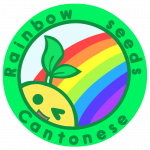
Rainbow Seeds Cantonese - How to Use HBL Stories to Teach Cantonese
Rainbow Sees Cantonese (RSC) has been teaching children from bilingual families (ages 3-10+) for about 5 years so we totally understand the difficulty of learning Cantonese. Learning to ‘Listen’ and ‘Speak’ is the priority before establishing the ability to ‘Read” and ‘Write’. Materials for learning Jyutping or speaking Cantonese are lacking in the market, or they are too advanced to non-native speaking children, eventually disinteresting them learning the language. I’m glad that I met Hambaanglaang (HBL), which added more diverse and fun content into RSC’s lessons for my students.
What are the features of HBL?
Colloquial Cantonese Stories
- HBL stories were inspired from daily life, easy to attract and interest the children. Their memories are easily strengthened when they encounter the same situation in real life too.
- The stories are written in conversational Cantonese with vocabularies and expressions which can be easily understood and applied to daily life. Eventually boost their speaking and communication skills.
Providing interesting stories in different levels
- From beginner level to advanced level, from simple words to complex sentences, children are learning the language step-by-step so they are confident to keep going.
- HBL website provides rich materials including illustrations and audio of the stories. Parents are encouraged to revise the stories with the children online. Printed books with exclusive content such as cultural introduction and English story (a different version of the story) are also available for purchase so parents can read together with their children.
How does HBL immerse into RSC’s lessons?
We hope students learn Cantonese step-by-step. First of all, we do storytelling in Cantonese in the class to encourage listening comprehension and speaking. Then, we apply multiple interactive games to teach Chinese characters and written Chinese for Reading and Writing. The demonstrations below are how we applied HBL into our learning activities and how the teacher encouraged the children to speak what they have learnt.
Video 1:https://youtu.be/abHS4IhsIbs
Video 2:https://youtu.be/qiNOHT2iEeg
Activity 1
- After telling the story in spoken Cantonese (Video 1), children will be asked to read aloud the sentences in written Chinese with the teacher. The teacher presents the vocabulary in pictures as these are the words they have learnt. The use of cute pictures facilitates their memory of the vocabulary as well as reduces their fear of Chinese characters.
Activity 2
- Word cards are designed to revise vocabulary in the story. Chinese characters of the terms used in spoken Cantonese and written Chinese are both there to allow children to understand the difference between the two. The illustration also explains the meaning and facilitated their recall of the vocabulary.
Activity 3
- Use of pictures to intensify the understanding of the character
Easy: Look at the character, choose the right picture with corresponding meaning
Challenge: All the pictures are related to the character. We hope to introduce them to more combinations of characters as well as expanded meanings. For example, ‘多(do1)’ means ‘more’. However, when it is combined with ‘謝(ze6)’, it means ‘thank you’. Both terms include the character ‘多’ but their meanings are distinct. This activity stimulates children’s thinking and further brings them to learn more vocabulary from one character.
Activity 4
- In order to let children understand the structure and the order of strokes of a Chinese character, some parts of a character are often hidden and children are asked to tell or write the remaining parts which they have learnt before. By doing so, they feel less stressed to memorize a character by the traditional method of copywriting. Instead, they are able to decode the construction of a Chinese character and be interested in recognizing the character.
Activity 5
- We make Cantonese listening practice fun with the good use of an online animal recording app to catch children’s attention as well as get them used to listening to Cantonese in different accents. Later on, they are asked to put the characters in the right order so the teacher can assess if the children are able to read and understand the sentence.
Activity 6
- When the vocabulary has been taught in several ways. We hide the characters to test if they still understand and memorise them.
How to teach Cantonese as a second language
We believe the RSC team are able to share the enthusiasm for Cantonese learning. Still, we understand that a new language cannot be fully acquired through a single course, the trick is to speak, read and write more in daily life. We invite the children to film their speaking practice after class. It’s encouraging to let them see their peers making progress while it is the best way to strengthen their pronunciation and speaking fluency outside the lesson.
English is the first language in the UK so children here rarely use Cantonese. We suggest parents spend more time studying and talking about the lesson materials in order to raise their experience and confidence in using the language. The more they feel comfortable using Cantonese, they have more sense of belonging to the language. This is the ultimate key to passing on Cantonese and its culture.
Online class registration
Other than the teaching activities mentioned above, RSC has developed more interesting classes to make children fall in love with Cantonese! Hambaanglaang storytelling class is now available, please sign up here (https://rainbowseedscantonese.com/pages/cantonese-group-lessons-for-children) if you are interested.
If you are in another time zone, welcome to contact us for an alternative teaching schedule. We also offer classes for bilingual children at different levels (Seeds/ Germination/ Sapling). The class demonstration can be watched on our website. Contact us for any inquiries. We are looking forward to the teaching methods shared by others too.
Website:https://
Facebook:https://www.facebook.
Instagram:https://www.
YouTube:https://www.youtube.
